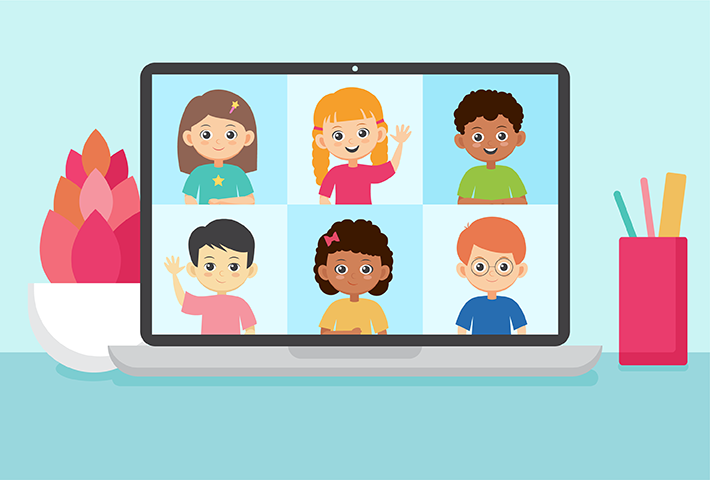5 minute read
During the COVID-19 pandemic, many obstacles have been simultaneously impacting k-12 education, including internet access, food and housing insecurity, and mental health. Recent data sheds light on the shortcomings of the virtual and hybrid models. Students are falling behind, and the achievement gap is growing for minority and homeless students. Mental health issues and domestic abuse cases are on the rise. Students are “Zoomed out,” feeling isolated, and many are failing due to absenteeism and/or WiFi connectivity issues. Teachers are under more scrutiny, and have to justify that the students are engaged to be marked as virtually present, causing over-reporting on absenteeism.
Internet Access
This fall, as schools returned to online learning, State officials determined that California students still needed more than 1 million computers and hot spots (A Generation Left Behind, Los Angeles Times, August 13, 2020). Pre-pandemic, 1.3 million children experiencing homelessness were identified in America’s public school system.
A recent 60 Minutes investigation found that hundreds of thousands of students are not showing up at all for online learning and are unaccounted for entirely. While underserved students may be set with laptops/Chromebooks through either their school districts or nonprofits, there remains a need for internet hot spots and technological support.
According to a recent LAUSD study, low-income students lag 10-20 percentage points behind their more affluent peers in their online learning participation rates. Students identified as homeless, or in foster care, have a weekly attendance rate of 50% or lower. The disparities become even greater when the data is separated out by race and ethnicity with white middle school students showing 88% online participation and white high school students with 85% online participation, compared to 67%/73% for Latinos and 67%/71% for Black students, respectively. These findings are consistent with those seen throughout Orange County.
At least 32,000 homeless school-aged children live in Orange County. These students struggle with Wi-Fi connectivity, and many homeless children previously had to go to a public library or try to study in free Wi-Fi locations (e.g., Starbucks) — options that the pandemic has eliminated.
Some are providing solutions. For example, JKF Transportation, a family business in Santa Ana, has been providing Wi-Fi on Wheels. Santa Ana Unified School District, where 10,000 kids are without Wi-Fi, has partnered with JKF Transportation to provide vans and buses with mobile routers that give access within 1,000 feet of where the vehicle is located. JKF Transportation has 150 vehicles, and each vehicle has the capability of reaching 200 students per bus. It costs JKF $479 per bus per day.
Food Insecurity
Many school aged children are facing food insecurity. Most families that have lost jobs are facing food scarcity and are struggling whether to pay for rent. Among low-income households with children who qualify for free or reduced-price school meals, only about 15% have been getting those meals, said Lauren Bauer, a researcher at the Brookings Institution. She's been pouring over the results of the U.S. Census Bureau's weekly Household Pulse Survey.
Mental Health
An alarming number of students are struggling with depression, mental health, and suicidal ideation. For young children that is tragic. The increase in depression is likely caused by not being able to socialize and limited human interaction. Recent Kaiser Family Foundation research shows that the pandemic has had major consequences for mental health, with 36.5% of U.S. adults reporting signs of anxiety or depression in June 2020, compared to only 11% in 2019. Nearly half of Kaiser survey respondents report negative mental health symptoms due to stress related to COVID-19, a figure that rises to 54% for those who have lost jobs or income due to the pandemic. Children are being affected as well as teenagers and adults. A survey of elementary school children during the first week of the nation's lockdown found the following:
- 84 percent of children reported their situation being either "a bit worse" or "much worse" than before; and
- Only 7 percent reported an improvement.
- 20% of college students say their mental health has worsened under COVID-19.
- 75% of all students reported their mental health has worsened (somewhat to significantly) during the pandemic.
- Respondents reported that “stress (84.25%), anxiety (82.35%), sadness (73.23%), and depression (60.7%) have all increased since the beginning of the pandemic.”
- 55% of all students do not know where to go for help for their mental health.
- 8 in 10 students are struggling with staying focused on school work.
- 74% of students are challenged in maintaining a routine due to the pandemic.
Mental health trends in 2020 observed by CHOC’s Cherese Mari Laulhere Mental Health Inpatient Center at include:
- Increase in social isolation is a major contributing factor in acute mental health hospitalization.
- Difference in clinical presentation of patients.
- Broader use of drugs leading to an increase in psychotic episodes.
- Severe/lethal suicidal attempts.
- Severe depression has increased while resources to de-escalate have decreased (e.g., friends, teachers, appropriate after care resources).
Furthermore, there is a substantial increase in the number of child abuse cases that are unreported or unidentified due to school closures. According to Child Abuse Statistics Application (CARSA) data, total child abuse referrals dropped in Orange County from 3,481 in January 2020 to 2,109 in July 2020, a decline of 39 percent, or 1,372 cases.
Conclusion
Key areas to support include:
- Secure internet connectivity;
- One-on-one mental health support to each student;
- Teacher development and training;
- Food for the most vulnerable;
- Programs that are technologically engaging; and
- Partnerships with organizations that are supplying tactile learning kits for students to use.
In summary, charitable donations are most needed to provide the following:
Connectivity and hotspots for students
Nonprofits include Project Hope Alliance, Boys and Girls Club of Central Orange Coast
Mental health support during and after the school hours for youth suffering with anxiety and depression
Nonprofits include The Priority Center, Western Youth Services, CHOC Children’s Foundation Mental Health Services and CASA
Professional development for teachers
Nonprofits include THINK Together / Orenda Partnership, MIND Research Institute, and Facing History and Ourselves
STEAM kits that sparks excitement, experiential learning, and creativity in students.
Nonprofits include ASTEME Learning Center, Child Creativity Lab, Dreams for Schools, MIND Research Institute
After-school programs that provide enrichment, academic support and mentorship beyond the classroom.
Nonprofits include Boys and Girls Club of Central Coast, Anaheim Family YMCA, THING Together and Girls Inc.
Nutritious meals for kids and their families
Bracken’s Kitchen, Catarina’s Club and Second Harvest Food Bank.
Sources:
2020-2021 Orange County Community Indicators Report
LA TIMES “Ds and Fs surge, attendance slips among L.A.'s poorest students amid distance learning” November 2, 2020
NPR “'Children Are Going Hungry': Why Schools Are Struggling To Feed Students” September 8, 2020
Orange County Register “Coronavirus sheds light on how many Southern Californians still lack internet access” April 6, 2020
Orange County Business Journal “Coronavirus sheds light on how many Southern Californians still lack internet access” August 31, 2020
Orange County Register “Coronavirus sheds light on how many Southern Californians still lack internet access” April 6, 2020
Orange County Register “For children living in motels, WiFi hot spots make school possible” October 11, 2020
Active Minds, “Student Mental Health Survey, Sept. 2020



